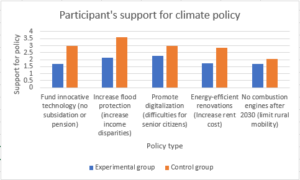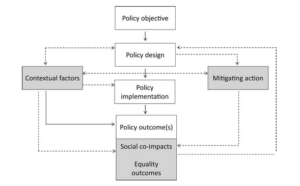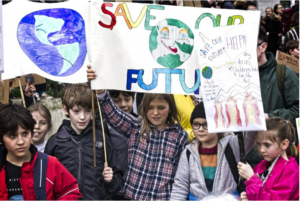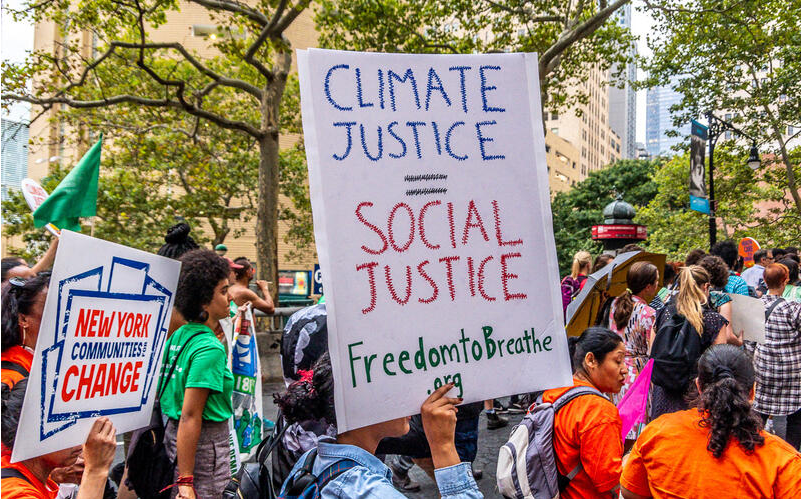US Climate Policy Structure is Flawed: Global climate change is a present and ongoing critical issue that we face today. Although some people question its existence, climate change is a fact supported by scientists around the world.1 The effects of climate change are becoming increasingly felt as both regional weather patterns and global temperatures become more extreme. Minority and low-income communities are among those disproportionately affected by the effects of climate change, making the need for effective climate policy not only an environmental issue, but also a social issue: “The poorest and marginalized populations (such as indigenous peoples) are least responsible for past greenhouse gas emissions (benefits), most vulnerable to climate change (costs), and possess least resources to adapt to extreme climate events and rising temperatures”.2 People that belong to a certain social category such as gender or ethnicity have an “increase in the likelihood of facing discrimination which – together with inequalities in terms of health, wealth and access to opportunities – increase people’s vulnerability and reduce their capacity to adjust to changing circumstances” caused by climate change. However, passing legislation to help ease the effects of climate change and the resulting social injustices, is not easy. Sometimes climate policies worsen social injustices as they limit the few resources available to minority or low-income people. For example, a poor, rural farmworker who uses fossil fuels to work their farm equipment may have to halt production if a climate policy restricting the use of fossil fuels is passed. Although this would be great for the climate, it puts low-income and minority people at a disadvantage as they may rely on cheap fossil fuels to make a living, and can’t afford electric, eco-friendly options. In the US, much of this inequality is driven by a flawed policy making structure. Policy makers often focus on completing the objective of passing legislation and often overlook or don’t completely understand the widespread impact the policy may have.
Disparities Caused by Climate Policy Reduce Voter Support: As briefly mentioned before, “Societies are currently struggling with a twofold global crisis. On the one hand, humanity surpassed such ecological limits as climate change, the biodiversity extinction rate and the nitrogen cycle for human uses a decade ago. On the other hand, poverty, inequality and discrimination are widespread and have been exacerbated by such events as the crisis in 2008. Environmental deterioration and socioeconomic problems are the two main challenges of the century”.3 Thus, climate policy that takes into account social justice is becoming increasingly important in order to combat these issues. With the right structure and enforcement, climate policies can bring positive social improvements by stopping the combustion of fossil fuels and preventing the sequential negative health impacts as well as by addressing fuel poverty in marginalized communities, to name a couple examples. However, if the impact it may have on certain social groups is not taken into account, climate policy can end up working against social improvement. For example, studies done in Denmark found that an environmental tax on carbon dioxide and transportation fuels, without compensation, resulted in a “higher cost burden for rural than urban households”.4 Due to this type of cost disparity that climate policy may cause, researchers conducted an experiment in Germany to see if public support for climate policy would change if voters were informed how the proposed changes would affect people of varying social groups. Researchers surveyed 2,233 participants of varying ages and incomes on their support for climate policy. Participants in a control group weren’t told of any potential negative impacts the climate policy may have on certain social groups. In contrast, participants in the experimental group were informed of possible negative social effects of the proposed climate policy. The researchers noted that, on average, participants in the experimental group were less supportive of climate policy than participants in the control group, and inferred that hearing about potential negative effects of the policy is likely to decrease public support (Figure 2).5 The results of this study demonstrate the importance in maintaining a balance between climate and social justice, because without one or the other, inequality and environmental degradation will continue. To maintain this balance, the current climate policy structure in the US must be adjusted to take into consideration possible negative outcomes that could result in disproportionate effects on certain groups.

Support for policy was given a numerical value where the higher the value, the greater the support for a specific policy. Demonstrates decrease in support when participants were aware of the potential negative impacts the policy would have on certain social groups.
More conservative officials typically support the continued use of fossil fuels, so climate policies that aren’t designed well and worsen social problems are used to to support the reductions in fossil fuel regulations and limit the passage of more climate policies. In addition to this division, people have gotten used to their current ways of living and want to keep it that way. This “status quo bias” makes it hard for any change to occur, especially change brought on by the passage of climate policies, because people don’t want to lose or change what they have, even if the change may be a better alternative.8
Without climate policies that regulate fossil fuels, however, greenhouse gas emissions like carbon dioxide, will continue to increase and environmental degradation will occur on a much larger scale which will greatly change the environment around us as temperatures increase and weather patterns become more severe. In fact, greenhouse gas emissions in 2019 increased by 12% since 2010 and increased by 54% since 1990, so adjusting the current climate policy structure to account for social impacts is of utmost importance in effectively combating climate change.9 The structure for climate policy needs to include the input of local communities that may be affected by its passage so government officials can have a better understanding on how their decisions can impact people in ways they can’t see.


- IPCC, 2023: Summary for Policymakers. In: Climate Change 2023: Synthesis Report. Contribution of Working Groups I, II and III to
the Sixth Assessment Report of the Intergovernmental Panel on Climate Change .Core Writing Team, H. Lee and J. Romero (eds.).
IPCC, Geneva, Switzerland, pp. 1-34, doi: 10.59327/IPCC/AR6-9789291691647.001 ↵ - Markkanen S, Anger-Kraavi A. 2019. Social impacts of climate change mitigation policies and their implications for inequality. Climate Policy. 19(7):827–844. doi:10.1080/14693062.2019.1596873. accessed 2023 Sep 15.https://www.tandfonline.com/doi/full/10.1080/14693062.2019.1596873. ↵
- García-García P, Carpintero Ó, Buendía L. 2020. Just energy transitions to low carbon economies: A review of the concept and its effects on labour and income. Energy Research & Social Science. 70:101664. doi:10.1016/j.erss.2020.101664. accessed 2023 Sep 15. https://www.sciencedirect.com/science/article/pii/S2214629620302395. ↵
- Lamb W, Antal M, Bohnenberger K. What are the social outcomes of climate policies? A systematic map and review of the ex-post literature – IOPscience. accessed 2023 Oct 24. https://iopscience.iop.org/article/10.1088/1748-9326/abc11f. ↵
- Rettig L, Gärtner L, Schoen H. 2023. Facing trade-offs: The variability of public support for climate change policies. Environmental Science & Policy. 147:244–254. doi:10.1016/j.envsci.2023.06.020. ↵
- Rettig L, Gärtner L, Schoen H. 2023. Facing trade-offs: The variability of public support for climate change policies. Environmental Science & Policy. 147:244–254. doi:10.1016/j.envsci.2023.06.020. accessed 2023 Oct 9. https://www.sciencedirect.com/science/article/pii/S1462901123001776. ↵
- Lamb W, Antal M, Bohnenberger K. What are the social outcomes of climate policies? A systematic map and review of the ex-post literature – IOPscience. accessed 2023 Oct 24. https://iopscience.iop.org/article/10.1088/1748-9326/abc11f. ↵
- Gilmore E, Lempert R. 2023 Mar 20. IPCC report: Climate solutions exist, but humanity has to break from the status quo and embrace innovation. The Conversation. accessed 2023 Oct 24. http://theconversation.com/ipcc-report-climate-solutions-exist-but-humanity-has-to-break-from-the-status-quo-and-embrace-innovation-202134. ↵
- IPCC, 2023. Summary for Policymakers. In: Climate Change 2023: Synthesis Report. Contribution of Working Groups I, II, and III to the Sixth Assessment Report of the Intergovernmental Panel on Climate Change. Core Writing Team: H. Lee and J. Romero (eds.). IPCC, Geneva, Switzerland, pp. 1-34 doi: 10.59327/IPCC/AR6-9789291691647.001 ↵
- Markkanen S, Anger-Kraavi A. 2019. Social impacts of climate change mitigation policies and their implications for inequality. Climate Policy. 19(7):827–844. doi:10.1080/14693062.2019.1596873. accessed 2023 Oct 9. https://www.tandfonline.com/doi/full/10.1080/14693062.2019.1596873. ↵
- Markkanen S, Anger-Kraavi A. 2019. Social impacts of climate change mitigation policies and their implications for inequality. Climate Policy. 19(7):827–844. doi:10.1080/14693062.2019.1596873. ↵
- Diezmartinez C, Gianotti A. US cities increasingly integrate justice into climate planning and create policy tools for climate justice – PMC. accessed 2023 Oct 24. https://www.ncbi.nlm.nih.gov/pmc/articles/PMC9524340/. ↵
- Chen A. 2019 Sep 19. Coming climate strike heats up campus – The Miscellany News. {accessed 2023 Oct 9}. https://miscellanynews.org/2019/09/19/news/coming-climate-strike-heats-up-campus/ ↵



2 comments
Samantha Aragon
Hi Tatiana, your article did a great job at explaining the importance of the fine balance in the relationship of climate change and social justice, how differing information input may affect how voters perceive climate change policies, and how climate policy can be improved. I never knew how closely related climate change and social change are. There was also a substantial amount of statistics and studies in this article that reinforced your points. Great job!
Norma Cardenas-Flores
I think that the point of view of the author and her approach to describing climate change and social injustice relationship was very well presented. Minorities and impoverished communities all around the world have always been the most affected by this.